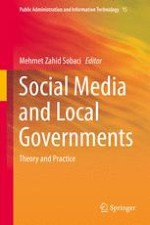2016 | OriginalPaper | Chapter
7. Social Media Adoption and Use by Australian Capital City Local Governments
Authors : Wayne Williamson, Kristian Ruming
Published in: Social Media and Local Governments
Publisher: Springer International Publishing
Activate our intelligent search to find suitable subject content or patents.
Select sections of text to find matching patents with Artificial Intelligence. powered by
Select sections of text to find additional relevant content using AI-assisted search. powered by
